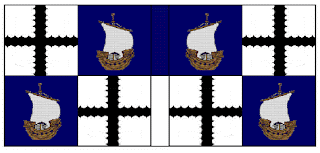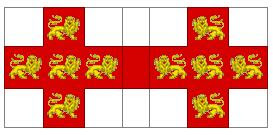"Not more flags", is all I'm hearing from my wargaming pals, granted its from the ones who don't have figures or ANY interest in the Battle of Flodden or Henry VIII's French campaigns. So just to please them all I thought I'd put some more flags on. Hopefully there's more people out there who like the flags than not!!
All the Lords in this post fought in the centre battle under the direct command of King James IV.
The flags themselves are taken from online sources, some from descriptions from the approxamate period some from coats of arms, so once again may not be 100% accurate. If anyone notices any mistakes on my part let me know and I'll try and put them right.
The first flag for today is that of Lord Herries. Andrew Herries 2nd Lord Herries of Terreglas was outlawed in 1507 and 1508 for killing George Sinclair of Highfield, but was pardoned around the 12 Dec 1508 on the intercession of the Queen of France. He was killed at Flodden.
The second flag belongs to John Maxwell 4th Lord Maxwell. The Maxwells were an ancient family from the Scottish Borders, whose chief seat was at Caerlaverock Castle. His notoriously assaulted Robert Crichton, 2nd Lord Crichton of Sanquhar outside the court house in Dumfries in 1508 where Crichton was holding assizes, he seems to have got away without being punished. Maxwell also lost his life during the battle.
The third flag belonged to Lord Innerwick, Alexander Hamilton the 3rd Lord of Innerwick died at Flodden. I struggeld with this flag, but found an obscure text about his coat of arms, I couldn't find any info about the man himself.
The fourth flag belongs to Lord Bothwick. Now he has confused the hell out of me, I've trawled the internet about William Borthwick but found lots of conflicting info, I'm not sure whether he was the 3rd of 4th Lord or was killed at the battle. The Borthwick officail website,
Link, says he was the 3rd and was killed at Flodden, while other sites say the 3rd Lord died in 1503????
The last flag belong to Lord Sempil. John Sempill, 1st Lord Sempill of Eliotstoun was the founder of the collegiate Church of Lochwinnoch and was created Lord Sempill in the Peerage of Scotland around 1489. He was killed at the Battle of Flodden in September 1513.



































